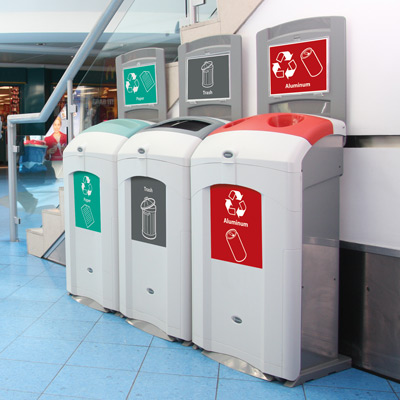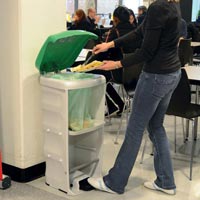Shopping malls are a popular hub for activity. A study by ICSC* found that on average, Americans visit a shopping center at least once a week, be it to buy merchandise, grab a bite to eat or socialize with friends.
Adopting sustainable practices within your shopping center can not only benefit your relationship with customers and the environment, but it can also help to cut costs and increase savings from recycling rates and reduced energy bills.

We’ve identified key ideas like this and more to help make your shopping mall more eco-friendly. Here are our top tips:
Make the switch to energy-efficient appliances
Reduce energy costs, conserve power and benefit the environment by switching to energy-saving applications and rechargeable power sources.

According to the U.S. Department of Energy**, energy-efficient light bulbs such as light emitting diodes (LEDs) and compact fluorescent lamps (CFLs) can last up to 25 times longer than traditional bulbs whilst using up to 80% less energy. Replacing just 5 bulbs can save up to $75 a year, which can amount to huge cost savings for shopping malls as well as a reduced environmental impact.
Cutting down on the use of single-use batteries can also help the environment. When sent to landfill, the chemicals within batteries can leak into the ground, causing detrimental effects to wildlife, crops and water sources. Switching to rechargeable batteries where possible will help to minimize this impact and conserve energy.
Once any used batteries are ready to be disposed of, deposit them in a battery recycling container to prevent them from going to landfill.
Find out more about how to dispose of e-waste, including batteries, here.
Don't forget to make sure any appliances such as cash registers, digital boards and lighting sources are switched off when not in use too!
Improve waste management facilities
Improving trash collection and recycling rates will help to keep your shopping mall clean, safe and aesthetically-pleasing, benefiting the environment as well as your business.
Visitors will typically dedicate just a fleeting moment of attention to what they are throwing away, so make sure you have an effective waste management program in place. Use clear signage to indicate whether the receptacles are intended for trash or recyclable materials, to minimize cross-contamination between waste streams and encourage use.

Did you know that as the distance between trash cans increases, so does the frequency of dropped litter?*** So make sure any waste containers are sited in high-traffic areas at regular intervals.
Our indoor recycling containers are available in co-ordinating ranges featuring different receptacles for different waste streams. These can be sited side-by-side to form an attractive recycling station. The Nexus® 26G Range of Recycling Containers are perfect for shopping centers due to their sizeable capacities and sleek, stylish designs.
For outdoor environments, we would recommend the Glasdon Jubilee™ 29G Trash and Recycling Combo, to create a trash and recycling collection bank for your guests upon leaving or entering your shopping mall.
Avoid single-use plastics
Single-use plastics are commonly distributed at fast-food courts within shopping malls, but they aren't necessarily the best choice, or the only option available.
Disposable plastics such as plastic straws and utensils can be difficult to recycle and take a long time to biodegrade, often resulting in them entering wider environments such as our oceans.

Simply providing alternatives such as compostable straws, paper plates and reusable utensils can help to reduce the negative impact of plastic waste on the environment.
Find out more about how to minimize plastic waste.
Where plastic bags and bottles are concerned, it may be a good idea to implement a recycling program within your shopping mall.
Site plastic bottle recycling containers near to vending machines and food service areas for visitors to deposit their bottles into once finished. Recycling containers for plastic bags should be sited near to entrances and exits to encourage others to deposit any unwanted plastics instead of placing them into the trash.
Prevent, recover and recycle food waste
How is organic waste disposed of within your shopping mall?

Waste from food scraps and coffee grounds can easily be diverted from landfill by introducing simple measures to prevent, recover and recycle commercial food waste. This can help to reduce greenhouse gas emissions and conserve water, as well as save money from costly waste collection services, allowing you to harvest the social, economic and environmental benefits.
One of the best ways of reducing food waste is to compost it. Site food waste recycling bins near to food courts and vendors within your mall, to encourage visitors to trash their food scraps responsibly. This food waste can then be composted and re-used to stop it from going to landfill.
Minimize cross-contamination of waste
34%**** of U.S. citizens drink coffee on the go, often from disposable coffee cups.
Due to a plastic-coated liner, paper coffee cups aren’t always recyclable, but more and more efforts are being made worldwide to expand cup recycling possibilities and keep disposable cups out of landfill.
To prevent contamination, coffee cups should be collected in dedicated cup recycling bins sited within your shopping center. Liquid reservoirs will enable any waste liquids to be poured away before depositing the empty cups into the container. Integral cup stacking tubes ensure that the cups can be flipped and correctly stacked to aid drying and improve waste segregation.
Paper receipts may also prove difficult to recycle. Due to contamination from dyes and ink, paper receipts are often unrecyclable and may contaminate other waste if placed into a paper recycling bin.
Encourage retailers within your shopping mall to avoid paper receipts and go digital instead. By sending e-receipts, this waste can be minimized easily, reducing not only landfill waste but paper and print costs too.
These simple changes can help to minimize landfill waste and contribute further to a more circular economy, benefiting both your business and the environment.
For more information on the Glasdon range of products for shopping malls that we offer, please feel free to browse our website, download our free brochures or contact us today!
Put your HTML text here



